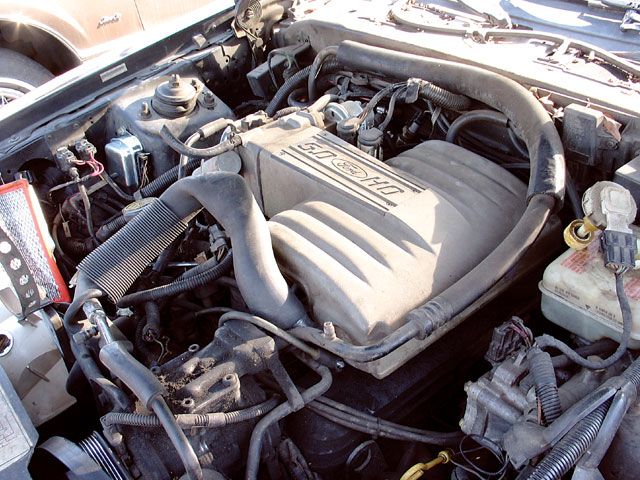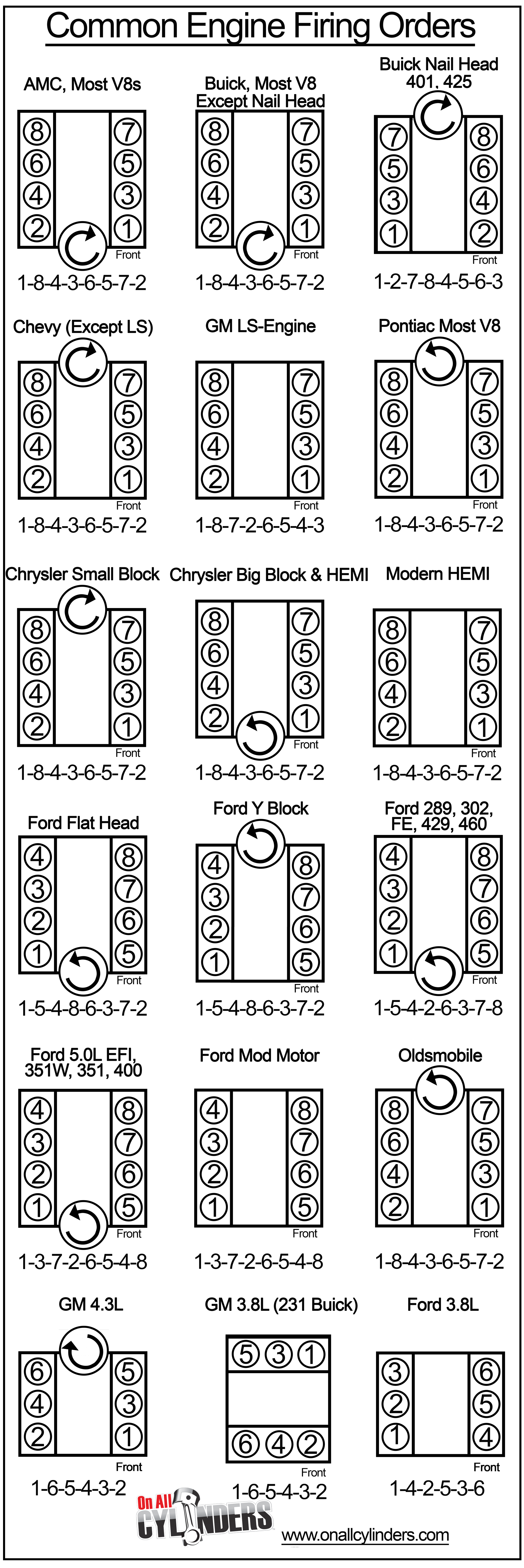
(Image/forums.nasioc.com – B6lovin)
Q: I’m building a Ford 302 engine, and I’m looking at camshafts. I’m curious—why did Ford change the firing order on the 5.0L (302) HO engine?
A: This question gets a lot of mileage on internet forums, and there’s no shortage of speculation on the subject.
According to Ford Motor Co. engineers, the 5.0L H.O. adopted the 351W firing order (1-3-7-2-6-5-4-8) to improve the intake manifold sound quality. Ford’s 5.0L H.O. has a distinct sound that benefits greatly from the addition of a cold air intake system and a pair of chambered mufflers.
Check out the V8 firing order chart and see how the 302 and 5.0L H.O. (listed below as the “5.0L EFI”) compare.

…
This is another in a series of weekly Q&A Mailbag sessions with Summit Racing‘s tech department, in which there are hundreds more. Click here to see them all.

Okay…let’s go back in time a bit and ask “Why did Ford change its long-established V8 firing order with the introduction of the 351W in ’69? It certainly WASN’T for “intake manifold sound quality”. The 385-series, which predates the 351W retains the “old” firing order while the 335-series, the HO and the Modular use the “new” firing order. Seems like there has to be ANOTHER reason….
I have a theory that the change in firing order is responsible for the great numbers of 5.0l blocks breaking crankshafts at the second main, probably the single greatest cause of catastrophic failure of these engines when pushed past 500hp, including severe splitting of cylinder blocks.
And the NON H.O. pattern would spit front main at 300hp levels… And it doesn’t help the 5.0 has puny mains… Yet 351s live at 700hp all day with the H.O. pattern they were develped with in 1968 (for 69 year)
It’s an upgrade, keeping cylinders 7 and 8 from firing consecutively. Also they had a windsor camshaft that had the specs they wanted, so to save money.
The revised firing order was needed to prevent inductive crossfire burning a hole through the center of number four piston. This would happen under load if the spark plug wires were not routed correctly on the right bank. I had to deny warranty on many 302 engines that we remanufactured for this reason. Not a problem with the 351W no matter where you ran the plug wires.
Terry Zeissler
Technical Services Manager (Retired)
Optimax Engine Reman (A NAPA Company)
[…] Small-block Fords have only one of two firing orders. The 302s and smaller will have one, and the 302 H.O.s and larger will have the other. Usually the […]
I have a 427 cu. inch DART block in my ‘88 Foxbody Mustang. The motor is a clone of the 351W. The firing order that I see around the rotation pattern of distributer is 1-2-6-3-7-5-4-8. Could someone out there let me know if I’m seeing “things”. (I don’t drink or do drugs) lol. My email address is mikekurki@gmail.com
You’re reading the distributor clockwise – it rotates counter- (or anti-, if you’re from across the pond) clockwise, as do all Ford V8s from the 1954 Y-blocks through the FEs, MELs, Super Duty, 90° series (small block), Cleveland, 335-series, and 385-series to the last distributor-equipped v-8s produced.
I have a 5.0 efi from an ’86 LTD crown vic. Is this considered an HO engine? which firing order? Can’t find compatable wiring harness for installing in old coupe
No the non-HO (any crown vic) engines even if they were EFI retained the original 302 firing order
What is the original firing order for
Fox body 302’s?
If you think for a second the crank determines the firing order of a motor. The pistons must be in the rite place or it wouldn’t work. So the only way you can change firing order is changing the crank. All you do for a cam is advance or retard your timing AKA spin the distributor. So when ford changed the firing order they changed the crank
Buddy, the intake has to open at a certain point. The crank doesn’t open the valve, the cam does. If you changed the crank you would open the chamber as the piston came up. That’s dumb. Get your retarted ass off of here please.
I’ve got nothing to add, I’m just posting so that we have a folk trio in the comments
I’m here to break up the act.
Wouldn’t Both the crank and the camshaft have to be cut for a certain firing order?? So that the piston is in the right place at the right time and the valves are opening and closing at the right time relative to the position of that piston?
Sorry to say this is incorrect. Because i can grab a 302 out of a 71 ford van pull the wayer pump timing chain cover and remove the stock cam. Grab a 351w cam off the shelf and put it in the 302. Change the plug wires adjust timing and let it ride.
I too, have a theory–not a very good one, but here it is regardless–the 1982-1984 302 H.O. camshaft is the same as the 1973 Ford Torino/Elite 351w camshaft, part number D3OE-6250-AA.
The 1985 Mustang with AOD and CFI also used this cam.
Can we at least presume that it might have been more economical or logistical for Ford to create castings for revised crank pin indexes to match the 351w’s than it would have been for Ford to create a new camshaft for the “normal” 302 firing order that would be analogous to the D3OE-6250-AA’s timing?
I’ll get to the bottom of this. A friend of a friend is a retired Ford engineer.
“Crank pin location”, “crank pin index”
NOPE
Same crank can use either cam. As Paul said above, the cam allows the air movement that the piston movement creates. In short- change the cam-change the firing order. You will notice that the GM firing order (18436572) matches the Ford firing order when you number the cylinders as GM does.
The LS series GM firing order matches the 351/302HO firing order when cyls are renumbered.
The clocking of the crank is the same.
Cam grinders will make the cam firing order for a GM (18436572),(18736542)[called 4/7 swap], or (18726543) [4/7-2/3 swap), all for the same crank.
Ford’s timing order doesn’t match a sbc or an ls…unless you’re talking about a y block or flat head. The 302/fe/385 and Windsor firing orders both have sequential firing of next door cylinders on one bank. 7 and 8 on one and 6 and 5 with the other. That event never happens in a Chevrolet engine. Ls is just a 4-7 swapped small block Chevy firing order. The crankshafts are clocked the same way…which is different in a ford.
I have a 1983 Ford Mustang put a new timing chain in it but as I put it back together I’m getting a loss of power when I celebrate hard underneath normal driving it seems to be fine but when I step down on the gas hard I get a pop I lost the power any suggestions please let me know
They did it to improve the intake sound quality, it’s all about engine knock
It is about engine knock. The 1-5 firing order hit the number 1 main twice 90 degrees apart and could cause engine knock at idle. The 1-3 firing order let the number 1 main “refill” with oil before firing on it again. There were Ford TSBs back in the day for 5.0Ls to change out main bearings selectively to get clearance right down to .001″ or even a little less.
If you number the cylinders of a GM LS engine as a Ford HO, you will find they have the same firing order. The crank throws are in the same position and I would suppose all 90 degree v-8 engines have the crank throws in the same position !
I have a 1965 modified pony. Should it be the regular firing order bcuz when I go back to the book & it doesn’t read the same as a stock 289 with allunimin heads & a pretty lumpy cam in it. What I am suppose to have in my modified 1965 pony is a 349 stroker engine but I believe it’s been pumped out from a 289 to a 349. The guy I bought from said it had 500 horse power. My question is to how to find the firing order pretty please and thank you so very much.
Respectfully,
John Lawlor in Abbotsford, BC
Bottom line, WHY did the larger cube 351 Windsor get this new firing order in 1969? After reading thru all the comments, appears minimizing cap walk in the wide skirt Windsor block would be the engineering benefit, as hp and trq increased with cubic inches. Beating out the front main vs another? Crank deflection from one end to the other? The Chevy conventional firing order 1-8-4-3-6-5-7-2 starts with #1 and ends with #2, placing the “one-two” 90-degree punch on the front throw. With the LS (Windsor) firing order 1-8-7-2-6-5-4-3, #2 and #3 are swapped, moving the “one-two punch” to the rear throw, cyl #8 & cyl #7. The second inherent “one-two” punch, a reality with all 90 degree V8 engines, remains at the third throw in both firing orders, with cyl #6 & cyl #5. We also have the destined pairs of “side by side” cylinders firing, effecting induction in the manifold, creating more heat at cyl #5 & cyl #7 in the Chevy. The #4 & #7 swap remedies this by moving the “side by side” to the opposite front of engine, cyl #4 & cyl #2. All I know is this, the 1986 FOX 302 HO has a sound we gearheads get giddy over! Is it the intake sound? Or the moving of the “double tap” from one exhaust pipe to the other? IMO it is both. Having the side-by-side firing cylinders closer to the radiator and water pump versus the firewall seems wise too. Block skirt & Main cap preservation, smoother crank harmonics, better induction pulse and SOUND, better block & head heat distribution, the sexiest 90 degree V8 sound in America.
So if I got a 1995 5.0 HO out of a Mustang GT and I go ahead and throw a carb set up on there, am I using the 5.0 HO firing order or a 302 firing order?